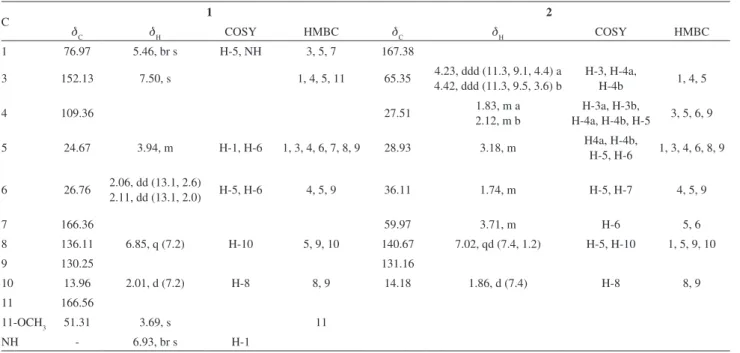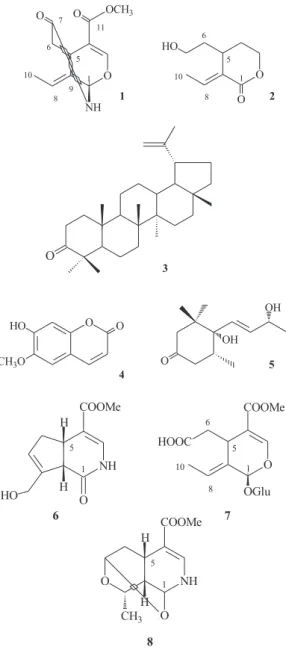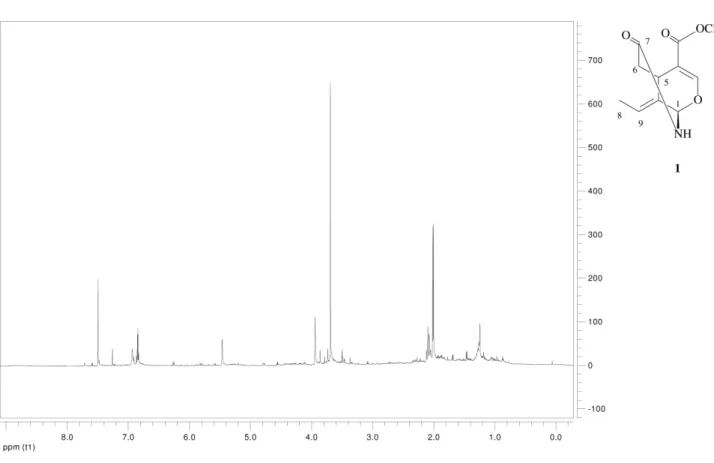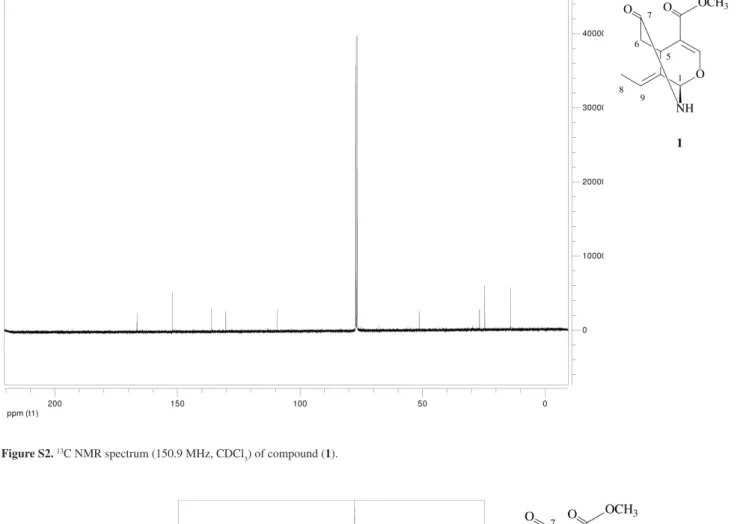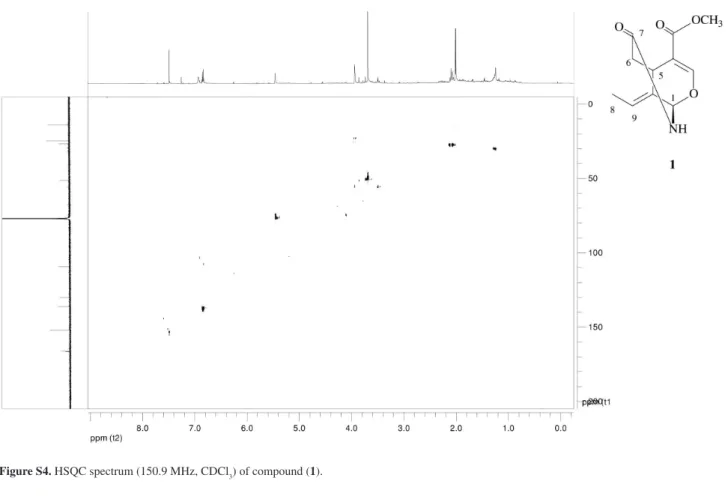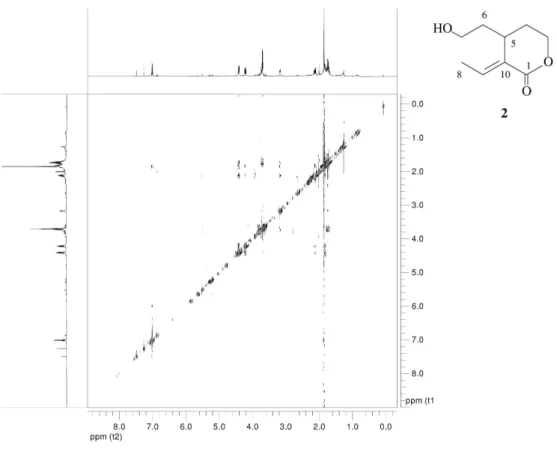Article
J. Braz. Chem. Soc., Vol. 21, No. 6, 1121-1125, 2010. Printed in Brazil - ©2010 Sociedade Brasileira de Química 0103 - 5053 $6.00+0.00
*e-mail: disabel@ubi.pt
Iridoids from
Hymenodictyon loribundum
Cristina M. P. Borges,a Carlos Diakanawmab and Dina I. M. D. de Mendonça*,c
aDepartamento de Química and bDepartamento de Biologia, Universidade Agostinho Neto,
Av. 4 de Fevereiro, 71, 2º andar, CP 3244, Luanda, Angola
cDepartamento de Química, Universidade da Beira Interior, Rua Marquês d’Ávila e Bolama,
6200-001 Covilhã, Portugal
Das cascas do tronco e das folhas do Hymenodictyon loribundum B. L. Rob foram isolados dois novos iridoides, loribundano A (1) e loribundano B (2), e três compostos conhecidos, lupenona (3), escopoletina (4) e 4,5-di-hidroblumenol A (5). As estruturas de todos os compostos foram estabelecidas com base nos seus dados espectroscópicos.
Two new iridoids loribundane A (1) and loribundane B (2) and the known compounds lupenone (3), scopoletin (4) and 4,5-dihydroblumenol A (5) were isolated from trunk bark and leaves of Hymenodictyon loribundum B.L. Rob. The structures of all compounds were established from their spectroscopic data.
Keywords:Hymenodictyon loribundum, monoterpenes, secoiridoids, nitrogen-containing iridoid, C-9 iridoid
Introduction
The Hymenodictyon genus comprises 22 species. Of these, 11 are endemic to Madagascar, 4 to Asia and 7 to Tropical Africa.1 Hymenodictyon loribundum B.L. Rob.
(Rubiaceae), endemic to Tropical Africa, is a small tree that grows in the mountains of the Huíla province and its traditional name is NDambi Yov`olwi, (omu)Lia-tyimeme. Its trunk bark is used in Angola folk medicine to treat fever.2
A previous study has shown that the trunk bark of this tree contains scopoletin, hymeselsin, scopolin and 3-O-β -D-glucopyranosyl-β-sitosterol.3 An exhaustive literature
review revealed that, with the exception of an ongoing study examining the trunk bark and dried leaves of Hymendictyon loribundum (in the context of other medicinal plants of Angola),4 other parts of the tree have not yet to be studied.
In the aforementioned study, powdered trunk barks and dried leaves were extracted by maceration with methanol. The methanol extract was partitioned with hexane and chloroform. The hexane extract from trunk barks yielded lupenone (3)5
and the chloroform extract yielded scopoletin (4).6 The
chloroform extract from dried leaves yielded loribundane A (1), 4,5-dihydroblumenol A (5)7,8 and loribundane B (2).
Results and Discussion
Floribundane A (1) was obtained as a colourless oil with [α]2
D
0 = +25.31º. The HR-TOF- EI-MS showed a
molecular ion peak at m/z 223.0843 [M]+(in agreement
with the molecular formula C11H13NO4) implying 6 degrees of unsaturation. The UV maximum at 234 nm and the IR absorptions at 1724, 1633 and 1268 cm-1 suggested
the presence of the chromophore −OOCC=CHO.9 The
IR also showed the presence of a lactam ring: NH band (3403 cm-1), and the amide band I (1690 cm-1) with an
absence of the amide II band.10 The 1H NMR spectrum of
compound (1) (Table 1) displayed signals of two vinylic protons (H-3 dH 7.50, s and H-8 dH 6.85, q, J 7.2), a ABX
system [H-6α,βdH 2.11, dd, J13.1 and 2.0; dH 2.06, dd, J13.1 and 2.6 (AB part) and H-5 dH 3.94, m (X part)]
and a vinyl methyl group at dH 2.01 (d, J 7.2); typical
signals of a secoiridoid nucleus.11 A few iridoid alkaloids
have been isolated from natural sorces12-15 (gardenamide
class), and some were obtained as metabolites produced by human16 and rat intestinal bacteria.17 Comparison with
the published data of known iridoid alkaloids, such as (6) (Figure 1), and hemiacetal-secoiridoids11,18 like (7) (Figure
Iridoids from Hymenodictyon loribundum J. Braz. Chem. Soc. 1122
the molecule, was more compatible with the hemiacetal-secoiridoids (dHca.7.5 ppm) than with the gardenamide
class and mor-117 (8) (Figure 1) (d
H ca. 7.3 ppm).
Further, the upield shift of H-1 (dH 5.46) relative to
the corresponding signal of mor-1 (dH 5.11 ppm), 17 and
a downield shift (dH 5.94 ppm) to the corresponding
hemicetals,11,18 showed that (1) it was neither a hemiacetal
nor a nitrogen-containing iridoid (N-2) but that it was compatible with a C-1(N)O-2 substitution. This was also supported by the presence of the 1H-1H COSY
correlation between H-1/NH, rather than the H-1/NH, H-3/NH correlations expected in the iridoid alkaloids,17
and by UV and IR data indicating the presence of the chromophore −OOCC=CHO.9 The 13C NMR spectrum
(Table 1) showed 11 carbons which were analysed as two methyls (one vinylic and a methyl ester), one methylene, four methines two of them vinylic, and four quaternary carbons (two vinylic and two carbonylic) from its DEPT spectrum. The 13C NMR chemical signals at d
C 152.13
(C-3), 136.11 (C-8), 130.25 (C-9), the carbonyl group at
dC 166.56, the methoxy signal at dC 51.31 and the vinyl
methyl group at dC 13.96, were found to be consistent
with a secoiridoid skeleton.11 The unusual downield shift
of C-1 to dC 76.97 was in agreement with the C-1(O)
(N) substitution as observed on mor-1,17 but only the
presence of O in the position 2 of the iridoid skeleton could explain the upield shift of C-3 and C-4. The HMBC correlation between H-1/C-7 established the presence of the 1,7-d-lactam ring in the molecule. With the aid of 1H – 1H COSY, HSQC and HMBC data (Table 1,
Figure 2) it was possible to establish the structure of (1) as a 7,8-secoiridoid, with C-11 as a methyl ester, a C-1(N) O-2 substitution and a 1,7-d-lactam ring. The NOESY correlations Hα-5/ Hα-6 and Hβ-6/Hβ-1 indicated that the 1,7-d-lactam ring is trans-fused. To our best knowledge, this is the irst time that a secoiridoid has presented as a 1,7-trans-d-lactam ring. A similar structure, isosweroside, as a hemiacetal, was found in the roots of Sambucus ebulus L.19 Compound (1) was named loribundane A.
Floribundane B (2) was obtained as a colourless oil with [α]2
D0 = + 41.66º. The molecular formula C9H14O3 was
established by HR-TOF-MS-EI which showed a molecular ion peak at m/z 170.0942 [M]+ (calculated for 170.2270),
implying 3 degrees of unsaturation. The IR showed OH bands (3384 cm-1), an α,β-unsaturated lactone group
(1692 cm-1, 1620 cm-1); the UV spectrum a α,β-unsaturated
lactone system (230 nm). The 1H RMN spectrum (Table 1)
showed signals of one diastereotopic oxymethylene (H-3)
dH 4.23 (ddd, J111.3, J29.1, J34.4 Hz) and dH 4.42 (ddd, J111.3, J29.5, J33.6 Hz) that presented 1H – 1H COSY
correlation with a diastereotopic methylene (H-4) dH 1.83
(m) and dH 2.12 (m); a oxymethylene multiplet dH 3.71
(H-7) that presented an 1H – 1H COSY correlation with
another methylene dH 1.74 (m, H-6); a methine dH 3.18
(m, H-5) that showed cross peaks with H-4 and H-6 and a vinyl methine dH 7.02 (qd, J17.4, J21.2 Hz, H-8) coupled
with a methyl dH 1.86 (d, J7.4 Hz, Me-10). This spectrum
presents some similarities to that of compound (1): the presence of the vinyl double bond and the 1H – 1H COSY
correlations between H-5, H-6 and H-7. Thus, it appears
Table 1.1H NMR and 13C NMR data (J in Hz) and HMBC correlations of compounds 1 and 2 (600 MHz, CDCl 3)
C 1 2
dC dH COSY HMBC dC dH COSY HMBC
1 76.97 5.46, br s H-5, NH 3, 5, 7 167.38
3 152.13 7.50, s 1, 4, 5, 11 65.35 4.23, ddd (11.3, 9.1, 4.4) a
4.42, ddd (11.3, 9.5, 3.6) b
H-3, H-4a,
H-4b 1, 4, 5
4 109.36 27.51 1.83, m a
2.12, m b
H-3a, H-3b,
H-4a, H-4b, H-5 3, 5, 6, 9
5 24.67 3.94, m H-1, H-6 1, 3, 4, 6, 7, 8, 9 28.93 3.18, m H4a, H-4b,
H-5, H-6 1, 3, 4, 6, 8, 9
6 26.76 2.06, dd (13.1, 2.6)
2.11, dd (13.1, 2.0) H-5, H-6 4, 5, 9 36.11 1.74, m H-5, H-7 4, 5, 9
7 166.36 59.97 3.71, m H-6 5, 6
8 136.11 6.85, q (7.2) H-10 5, 9, 10 140.67 7.02, qd (7.4, 1.2) H-5, H-10 1, 5, 9, 10
9 130.25 131.16
10 13.96 2.01, d (7.2) H-8 8, 9 14.18 1.86, d (7.4) H-8 8, 9
11 166.56
11-OCH3 51.31 3.69, s 11
Borges et al. 1123 Vol. 21, No. 6, 2010
methylenes (two of them oxymethylenes, dC 27.51, 36.11,
59.97, 65.35), two methines (one vinylic, dC 28.93, 140.67),
and two quaternary carbons (one vinilyc, dC 131.16, and
the other carbonylic, dC 167.38). The lack of the two
quaternary sp2 carbons belonging to the C-3 - C-4 double
bond of (1) and the methine C-1, and the presence of signals characteristic of a methylene (dC 27.51), a oxymethylene
(dC 65.35) and a sp
2 carbon (d
C 167.38) belonging to the α,β-unsaturated lactone group detected in the IR and UV spectra, is indicative of a major transformation in the B ring of (2). However, these new features of the B ring are in good agreement with those of the d-lactone ring of C-9 iridoid derivatives viteoid II,20,21 7-hidroxyviteoid
II22 and ovatolactone.23 The vinylic double bond can
unambiguously be assigned to C-8 and C-9 and the lactone carbonyl to C-1, by means of 1H – 1H COSY, HSQC and
HMBC data (Table 1, Figure 2). Several C-9 iridoid and secoiridoid (lactone ring opening) derivatives are known20-25
but to our best knowledge this is the irst time that a C-9 7,8-secoiridoid derivative has been isolated. Thus, (2) was identiied as a new natural product for which we propose the name loribundane B.
Conclusions
Although trunk bark components of H.loribundum have been well studied, there has as yet been no study which focuses solely on the leaves of this medicinal tree. The major compound trunk bark extract is scopoletin. The occurrence of iridoids has been observed for the irst time in this genus. A new secoiridoid alkaloid, loribundane A, and a C-9 7,8-secoiridoid, loribundane B was isolated from the leaves of this tree.
Experimental
General experimental procedures
O p t i c a l r o t a t i o n s w e r e o b t a i n e d w i t h a Bellingham+Stanley Ltd ADP 220 polarimeter. HREIMS measurements were carried out on a VG Autospec M and recorded at 70 eV. FTIR and UV spectra were measured in a Unicam Mattson 5000 FTIR and Unican Heλios α respectively. NMR spectra were recorded in a Bruker Avance II, 600 MHz (1H NMR) and 150.9 MHz
(13C NMR), in CDCl
3. Chemical shifts are given in d ppm
and are referenced to the residual CHCl3, 7.26 ppm for the
1H and 77.0 ppm for 13C. Two-dimensional experiments
were performed with standard Bruker software. Column chromatography was carried out on silica gel (silica gel 60 (70-230 mesh), Merck, Darmstadt, Germany).
Figure 2. Key HMBC correlations of compounds 1 and 2.
Figure 1. Structures of selected examples of iridoid alkaloids13 (6),
hemiacetal-secoiridoids11 (7) and mor-1 (8).17
that the A ring, as in (1), is open as a 7,8-secoiridoid with a hydroxyl moiety at C-7. The 13C NMR spectrum
Iridoids from Hymenodictyon loribundum J. Braz. Chem. Soc. 1124
Plant material
Leaves and bark of Hymenodictyon loribundum were collected in the waterfall at the Comuna da Huíla, Huíla province, Angola in July 2001. A voucher specimen (3668) has been deposit at the Lubango Herbarium, Angola.
Extraction and isolation
Powdered trunk bark (3 kg) was extracted with methanol for a week at room temperature. The methanol extract was partitioned between MeOH-H2O (5:1) and hexane yielding 16.6 g of the hexane extract. The aq. methanolic fraction was concentrated, H2O added and extracted with chloroform to obtain the chloroform extract (36.8 g). A sample of the hexane extract (4.7 g) was fractionated in silica gel column with a hexane/EtOAc, EtOAc and EtOAc/MeOH gradients. The fraction eluted with hexane/EtOAc (95:5) was separated in silica gel column with ahexane/EtOAc gradient to yield lupenone (3) (20.3 mg). From the chloroform extract and by crystallization scopoletin (4) (30 g) was isolated.
Dried leaves (0.9 kg) were extracted with methanol for a week at room temperature. The methanol extract was partitioned between MeOH-H2O (5:1) and hexane yielding 34.02 g of the hexane extract. The aq. methanolic fraction was concentrated, H2O added and extracted with chloroform to obtain the chloroform extract (5.2 g). A sample of the chloroform extract (1.6 g) was fractionated in silica gel column with a hexane/EtOAc, EtOAc/CHCl3 and EtOAc/MeOH gradients. Two fractions were eluted with EtOAc/CHCl3 (7:3) (fraction I and II). Fraction I was separated in silica gel column with CHCl3 and a CHCl3/ MeOH gradient to yield loribundane A (1) (10.2 mg) and 4,5-dihydroblumenol A (5) (5.6 mg). Fraction II was separated in silica gel column with CHCl3 and a CHCl3/ MeOH gradient to yield loribundane B (2) (7.8 mg).
Floribundane A (1) Oil; [α]2
D0 = +25.31º (CHCl3, c 0.079). FTIR (ilm) νmax/cm-1: 3403, 2959, 2930, 1724, 1690, 1633, 1379,
1268, 1196, 1092, 943, 756; UV (MeOH) λmax/nm (log ε): 234 (4.00), 210.0 (4.15) 1H NMR (CDCl
3, 600 MHz) and
13C NMR (CDCl
3, 150.9 MHz): see Table 1; TOF-MS-EI
pos: m/z 223 [M]+ (15), 206 (77), 190 (100), 164 (62), 163
(12), 162 (11), 149 (28), 146 (22), 134 (11), 122 (23), 121 (82), 120 (13), 93 (13), 83 (13), 79 (10); HREIMS: m/z 223.0843 [M]+ (calc. for C
11H13NO4, 223.0845).
Floribundane B (2) Oil; [α]2
D
0 = +41.66º (CHCl
3, c 0.048). FTIR (ilm) νmax/cm-1: 3384, 2962, 2926, 2866, 1692, 1620, 1262, 1154,
1094, 1060, 1026, 800, 760;UV (MeOH) λmax/nm (log ε): 230 (3.16), 219 (3.34). 1H NMR (CDCl
3, 600 MHz) and
13C NMR (CDCl
3, 150.9 MHz) see Table 1; TOF-MS-EI
pos: m/z 226 [M]+ (1), 168 (25), 137 (11), 135 (12), 128
(19), 126 (39), 125 (31), 124 (34), 123 (38), 122 (11), 121 (24), 111 (100), 110 (29), 109 (73), 108 (12), 107 (22), 99 (15), 98 (17), 97 (33), 96 (17), 95 (72), 93 (17), 91 (14), 85 (81), 84 (11), 83 (11), 83 (32), 82 (19), 81 (40), 79 (17), 77 (12), 71 (39), 69 (46), 67 (20); HREIMS: m/z 170.0942 [M]+ (calc. for C
9H14O3, 170.2270).
Supplementary Information
1H NMR, 13C NMR, 1H-1H COSY, HSQC, HMBC, and
NOESY NMR spectra of compounds 1 and 2 are available free of charge at http://jbcs.sbq.org.br, as PDF ile.
Acknowledgments
This work was partially funded by the project POCTI/ QUI/39380/2001 of Fundação para a Ciência e Tecnologia (FCT) with FEDER funding and Textile and Paper Materials Center. One of the authors (C.B.) gratefully acknowledges a GRICES PhD scholarship and INABE (Angola) for inancial support.
References
1. Razaimandimbison, S. G.; Bremer, B.; Bot. J. Linn. Soc. 2006, 152, 331.
2. Bossard, E.; Medicine Traditionnelle au Centre et a l’Ouest de l’Angola, Vol. 1, Ministério da Ciência e Tecnologia, Instituto de Investigação Cientíica Tropical: Lisbon, 1996.
3. Mitaine-Offer, A. C.; Tapondjou, L. A.; Djoukeng, J. D.; Bouda, H.; Lacaille-Dubois, M. A.; Biochem. Syst. Ecol.2003, 31, 227. 4. dos Santos, A. F.; Lopes, L. A.; Mata, R. C. S.; de Mendonça, D.
I. M. D.; Sant’Ana, A. E. G.; Bioresour. Technol. 2007, 98, 135. 5. Atta-Ur-Rahman; Pentacyclic Triterpenoids, Vol II, Elsevier
Science B.V.: Amsterdam, 1994.
6. Rao, P. S.; Asheervadam, Y; Khaleelullah, M.; Rao, N. S.; Murray, R. D. H.; J. Nat. Prod. 1988, 51, 959.
7. de Marino, S.; Borbone, N.; Zollo, N.; Ianaro, A.; Di Meglio, P.; Iorizzi, M; J. Agric. Food Chem.2004, 52, 7525.
8. Gonzalez, A. G.; Guillermo, J. A.; Ravelo, A. G.; Jiménez, I. A.; Gupta, M. P.; J. Nat. Prod.1994, 57, 400.
9. Zuleta, L. M. C.; Cavalheiro, A. J.; Silva, D. H. S.; Furlan, M.; Young, M. C. M.; Albuquerque, S.; Castro-Gamboa, I.; Bolzani, V. S.; Phytochemistry2003, 64, 549.
Borges et al. 1125 Vol. 21, No. 6, 2010
11. Shen, Y. C.; Lin, S. L.; Chein, C. C.; Phytochemistry1996, 42, 1629.
12. Machida, K.; Onodera, R.; Furuta, K.; Kikuchi, M.; Chem. Pharm. Bull.1998, 46, 1295.
13. Bringmann, G.; Hamm, A.; Kraus, J.; Ochse, M.; Noureldeen, A.; Jumbam, D. N.; Eur. J. Org. Chem. 2001, 1983.
14. Juma, B. F.; Majinda, R. R. T.; Nat. Prod. Res.2007, 21, 121. 15. Ono, M.; Ishimatsu, N.; Masouka, C.; Yoshimitsu, H.;
Tsuchihashi, R.; Okawa, M.; Kinjo, J.; Ikeda, T.; Nohara, T.; Chem. Pharm. Bull.2007, 55, 632.
16. Kawata, Y.; Hattori, M.; Akao, T.; Kobashi, K.; Namba, T.; Planta Med.1991, 57, 536.
17. Li, X.; Huo, C.; Wang, Q.; Zhang, X.; Sheng, X.; Zhang, L.; J.Pharm. Biomed. Anal.2007, 45, 268.
18. Tanahashi, T.; Takenaka, Y.; Nagakura, N.; J. Nat. Prod.1997, 60, 514.
19. Gross, G. A.; Sticher, O.; Helv. Chim. Acta1986, 69, 1113. 20. Ono, M.; Ito, Y.; Kubo, S.; Nohara, T.; Chem. Pharm. Bull.
1997, 45, 1094.
21. dos Santos, T. C.; Schripsema, J.; Monache, F. D.; Leitão, S. G.; J. Braz. Chem. Soc. 2001, 12, 763.
22. Gouda, Y. G.; Abdel-baky, A. M.; Darwish, F. M.; Mohamed, K. M.; Kasai, R.; Yamasaki, K.; Phytochemistry2003, 63, 887. 23. Machida, K.; Ando, M.; Yaoita, Y.; Kakuda, R.; Kikuchi, M.;
Chem. Pharm. Bull.2001, 49, 732.
24. Marini-Bettolo, G. B.; Nicoletti, M.; Messana, I.; Patamia, M.; Galefi, G.; Oguakwa, J. U.; Portalone, G.; Vaciago, A.; Tetrahedron 1983, 39, 323.
25. Valladares, M. G.; Rios, M. Y.; J. Nat. Prod.2007, 70, 100.
Supplementary Information
J. Braz. Chem. Soc., Vol. 21, No. 6, S1-S7, 2010. Printed in Brazil - ©2010 Sociedade Brasileira de Química 0103 - 5053 $6.00+0.00
*e-mail: disabel@ubi.pt
Iridoids from
Hymenodictyon loribundum
Cristina M. P. Borges,a Carlos Diakanawmab and Dina I. M. D. de Mendonça*,c
aDepartamento de Química and bDepartamento de Biologia, Universidade Agostinho Neto,
Av. 4 de Fevereiro, 71, 2º andar, CP 3244, Luanda, Angola
cDepartamento de Química, Universidade da Beira Interior, Rua Marquês d’Ávila e Bolama,
6200-001 Covilhã, Portugal
Figure S1. 1H NMR spectrum (600MHz, CDCl
Iridoids from Hymenodictyon loribundum J. Braz. Chem. Soc. S2
Figure S2. 13C NMR spectrum (150.9 MHz, CDCl
3) of compound (1).
Figure S3. 1H – 1H COSY spectrum (600 MHz, CDCl
Borges et al. S3 Vol. 21, No. 6, 2009
Figure S4. HSQC spectrum (150.9 MHz, CDCl3) of compound (1).
Iridoids from Hymenodictyon loribundum J. Braz. Chem. Soc. S4
Figure S6. NOESY spectrum (600 MHz, CDCl3) of compound (1).
Figure S7. 1H NMR spectrum (600 MHz, CDCl
Borges et al. S5 Vol. 21, No. 6, 2009
Figure S8. 13C NMR spectrum (150.9 MHz, CDCl
3) of compound (2).
Figure S9. 1H – 1H COSY spectrum (600 MHz, CDCl
Iridoids from Hymenodictyon loribundum J. Braz. Chem. Soc. S6
Figure S10. HSQC spectrum (150.9 MHz, CDCl3) of compound (2).
Borges et al. S7 Vol. 21, No. 6, 2009
